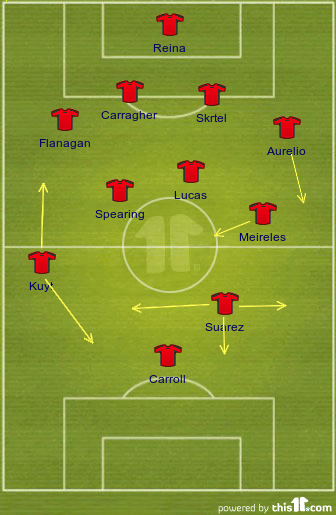"Football is not a predictable game. A team can have 20 chances and still lose to a side that musters only one. All a coach can do is manipulate the percentages as best he can in his favour. With that caveat in mind, though, a prediction – in the next decade, no side will win a major international tournament playing an orthodox 4-4-2.
"When a good side play with three central midfielders, whether in a 4-2-3-1 or a 4-3-3 (or either of their close cousins, 4‑2‑1‑3 and 4-1-2-3), they will almost inevitably dominate possession against a side playing only two central midfielders. The old defence of a high offside line simply is not as effective as it used to be thanks to the liberalisation of the rule.
"Even if the three do not dominate possession, fielding only two central midfelders leaves a side vulnerable if one of those central players pushes forward, a problem that dogged Manchester United in European competition for much of the late 1990s..."
Clearly Wilson focuses exclusively on the negative aspects of the 4-4-2 - it does, of course, have its merits - but the points he makes are important ones. Due to a numerical disadvantage in central midfield, teams playing a 4-4-2 will generally struggle to dominate possession, and will often leave too much space between the lines for the opposition to exploit.
With this in mind (I am not, generally, a fan of the 4-4-2 formation), and also on the basis of the different players we had available at the time (since the 25th of March, Agger, Johnson, Kelly and Gerrard have all been ruled out injured for the rest of the season), I suggested that Liverpool should be playing a 4-3-3 formation with Suarez stationed ostensibly on the left-wing in my piece 'A few tactical points for the rest of the season.'
The side we fielded against City and will probably field against Arsenal is not greatly different from this 4-3-3 - the key change being that Meireles now takes up a left-sided position and Suarez moves more centrally (although of course he is free to move across the entire pitch in search of space). In reality, despite the change in notation from 4-3-3 to 4-4-2, the differences are not overly insignificant, because Meireles will regularly look to cut inside, doing much of his defensive and attacking work in the centre of the pitch, and Suarez will often move to the left touchline to receive the ball (see the chalkboards below). It seems that Meireles played as a 'wide-central-midfielder' against City (see Zonal Marking's 'central winger' article if you find my terminology counterintuitive).

There are pros and cons of giving a central-midfielder a wide role. On the plus-side, if wide players 'tuck in' it can create more simple passing options for the central midfielders, making it easier for teams to retain possession and counteracting some of the weaknesses of the 4-4-2 formation in general. Wide players cutting in also creates space for the full-back to charge forward, which is increasingly important in today's game, but it also ensures that there is player with adequate defensive skills always available to help double-up on opposing wingers. Watch how Aurelio combined with Meireles, and occasionally Suarez, in this compilation of his performance vs. Man City (via @milankakabaros):
On the other hand, wide-players who don't offer much in terms of pace, skill, and ability to beat their man can often become passengers, and leave the team stunted in attack. Maxi Rodriguez (sometimes unfairly) has this criticism levelled at him - despite often playing a similar role to Meireles, it is expected that a certain degree of flair and creativity come from the wide-players, especially in terms of beating the full-back, getting to the by-line and crossing the ball for the likes of Carroll to attack. This is part of a more general problem, that playing central midfielders on the wing can mean the team severely lacks width, making them predictable and staid, especially if the full-backs can't get forward, or the forwards don't pull wide often enough.
Fortunately, Liverpool's energy and inventiveness against City ensured that this wasn't a problem, but at the Emirates on Sunday this system might be tested more sternly. For starters, we can assume that Van Persie will do a better job of occupying Liverpool's centre-backs than Dzeko did, which will leave Carragher less free to move across and support the fledgling Flanagan. Kuyt will have to produce a similarly heroic performance in terms of tracking back, tackling and closing down if Arsenal's left-sided players - i.e. Clichy and (probably) Arshavin - are to be stopped. Also, there is a hell of a lot more creativity in a midfield containing Nasri, Wilshere and Fabregas than was offered by Barry, Milner and Toure, so Lucas and Spearing (and Meireles) will have to be vigilant in their closing down and denying them space between the lines. Still, Suarez should be able to find space if Arsenal's midfield pushes forward, and Carroll is exactly the kind of physical, fearsome forward that can cause the likes of Koscielny and Squillaci/Djourou problems. It should be an interesting game.

No comments:
Post a Comment